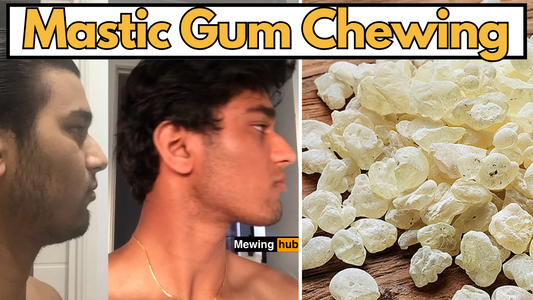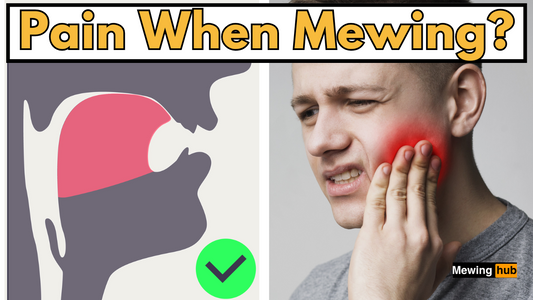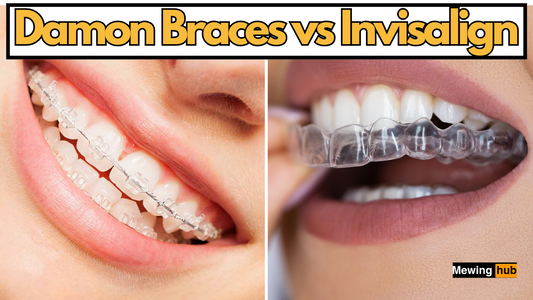Is It Normal to Experience Pain When Mewing? A Guide for Beginners

Share
Mewing, the practice of proper tongue posture popularized by Dr. Mike Mew, has gained significant attention for its potential benefits in facial aesthetics and oral health.
However, many beginners wonder: Is it normal to experience pain when mewing? This comprehensive guide will explore the causes of discomfort, how to address it, and when to seek professional help.
Understanding Pain When Mewing
While mewing shouldn't be inherently painful, it's not uncommon for beginners to experience some discomfort. Here's what you need to know:
- Mild discomfort is normal at first
- Pain could indicate improper technique
- Persistent pain may require professional evaluation
Normal Discomfort vs. Concerning Pain

It's important to distinguish between normal adjustment discomfort and problematic pain:
- Normal: Mild soreness in tongue muscles, slight jaw fatigue
- Concerning: Sharp pain, persistent headaches, jaw clicking
Common Causes of Pain When Mewing

Several factors can contribute to pain when mewing:
1. Incorrect Tongue Positioning
Many beginners experience pain when mewing due to improper tongue placement. Common mistakes include:
- Pushing too hard with the tongue
- Focusing only on the tip of the tongue
- Clenching the jaw excessively
2. Muscle Fatigue
Mewing engages muscles that may not be used to constant activation. This can lead to:
- Tongue muscle soreness
- Jaw muscle fatigue
- Temporary discomfort in the facial muscles
3. Pre-existing Dental or Jaw Issues
Some individuals may experience pain due to underlying conditions:
- Temporomandibular joint (TMJ) disorders
- Misaligned teeth or bite issues
- Existing facial asymmetries
How to Alleviate Pain When Mewing
If you're experiencing discomfort, try these strategies:
1. Start with "Soft Mewing"
Begin with gentle tongue pressure to allow your muscles to adapt gradually.
2. Practice Proper Technique
Ensure your entire tongue rests on the palate, not just the tip.
3. Gradually Increase Duration
Start with short mewing sessions and slowly increase the duration as your muscles adapt.
4. Maintain Proper Posture
Correct overall posture can help reduce strain on your jaw and facial muscles.
5. Stay Hydrated
Proper hydration can help reduce muscle soreness and fatigue.
The Importance of Consistency and Patience
Remember, mewing is a long-term practice. Consistency is key, but don't push through severe pain. Some tips for maintaining consistency include:
- Set reminders to check your tongue posture throughout the day
- Practice mewing during specific daily activities, like reading or watching TV
- Use a mewing tracking app to monitor your progress and stay motivated
When to Seek Professional Help

While some discomfort is normal, certain symptoms warrant professional attention:
- Persistent pain lasting more than a few weeks
- Jaw clicking or locking
- Severe headaches or facial pain
- Noticeable changes in bite alignment
Consult an orthodontist or dentist familiar with mewing if these issues arise.
Potential Risks of Incorrect Mewing
It's important to be aware of potential risks associated with improper mewing technique:
1. Temporomandibular Joint (TMJ) Disorders
Excessive pressure or improper jaw positioning can lead to TMJ issues, causing pain and dysfunction in the jaw joint.
2. Dental Misalignment
Applying too much force with the tongue can potentially affect tooth alignment over time.
3. Facial Asymmetry
Uneven tongue pressure may exacerbate or create facial asymmetries.
Tips for Safe and Effective Mewing
To minimize the risk of pain and maximize the benefits of mewing:
- Start slowly and gradually increase intensity
- Focus on maintaining a relaxed jaw position
- Ensure proper breathing technique, primarily through the nose
- Take breaks if you experience discomfort
- Combine mewing with overall good oral hygiene practices
The Role of Age in Mewing Discomfort
Age can play a factor in how your body responds to mewing:
Younger Individuals (Teens and Early 20s)
- May adapt more quickly to new tongue posture
- Potentially experience less discomfort due to greater bone plasticity
Older Adults
- May experience more initial discomfort as facial structures are less malleable
- Might require more time to see results and adapt to the new posture
Conclusion: Navigating Pain When Mewing
In conclusion, while mild discomfort when starting mewing is normal, persistent pain is not. Focus on proper technique, start gently, and be patient with your progress. If pain persists or worsens, don't hesitate to seek professional guidance. Remember, the goal of mewing is to improve oral posture and health, not to cause pain or damage.
By understanding the difference between normal adjustment discomfort and concerning pain, you can approach mewing safely and effectively, potentially reaping its benefits without unnecessary risk. Stay consistent, listen to your body, and remember that proper tongue posture should feel natural and comfortable over time.








